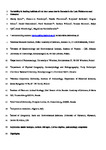Variability in feeding habitats of red deer sensu lato in Eurasia in the Late Pleistocene and Holocene
| dc.contributor.author | Sykut, M | |
| dc.contributor.author | Pawełczyk, S | |
| dc.contributor.author | Piotrowska, N | |
| dc.contributor.author | Stefaniak, K | |
| dc.contributor.author | Ridush, B | |
| dc.contributor.author | Makowiecki, D | |
| dc.contributor.author | Kosintsev, P | |
| dc.contributor.author | Wilkens, B | |
| dc.contributor.author | Borowik, T | |
| dc.contributor.author | Fyfe, R | |
| dc.contributor.author | Woodbridge, Jessie | |
| dc.contributor.author | Niedziałkowska, M | |
| dc.date.accessioned | 2023-01-25T09:17:31Z | |
| dc.date.available | 2023-01-25T09:17:31Z | |
| dc.date.issued | 2023-02 | |
| dc.identifier.issn | 0305-4403 | |
| dc.identifier.issn | 1095-9238 | |
| dc.identifier.other | 105726 | |
| dc.identifier.uri | http://hdl.handle.net/10026.1/20205 | |
| dc.description.abstract |
Red deer (Cervus elaphus) is one of the species that is rather wide spread and survived across Europe over the Holocene. The analyses of carbon and nitrogen stable isotopes in bone collagen of ungulate remains have been applied in paleoecological studies as environmental and dietary indicators. In this study we present the carbon and nitrogen stable isotope compositions of previously radiocarbon-dated red deer bone samples (N = 68) found in Central, Southern and Eastern Europe and Asia and aligned to one of two species: European red deer (Cervus elaphus) and wapiti (Cervus canadensis). We showed that the values of carbon and nitrogen stable isotope ratios of European red deer and wapiti overlapped. Among all analysed independent factors (determined for the locality and time period relevant for each of the analysed samples), the variability of δ13C values in European red deer dated to the Holocene is best explained by forest cover and mean July temperature, and variability of δ15N values by the mean July temperature, annual precipitation and altitude. Additionally, combining the results of the present study with isotopic data on European red deer collected from published sources, we revealed that the values of δ13C and of δ15N in C. elaphus bones changed according to environmental oscillations that took place in Europe over the last 50 000 years. We concluded that red deer shifted their feeding habitats in relation to changing environmental conditions, for example, forest expansion during the climate warming, and in the mid to later Holocene in response to deforestation caused by human activity and the spread of agriculture. We also found out that red deer reacted in varied ways to changing local conditions in different regions of Europe. Modern individuals of C. elaphus had the lowest δ13C values among all analysed specimens, so they probably inhabited the most densely forested areas in comparison to other European red deer populations during the last 50 000 years. | |
| dc.format.extent | 105726-105726 | |
| dc.language | en | |
| dc.language.iso | en | |
| dc.publisher | Elsevier BV | |
| dc.subject | Stable isotopes | |
| dc.subject | Carbon | |
| dc.subject | Nitrogen | |
| dc.subject | Cervus elaphus | |
| dc.subject | Paleoecology | |
| dc.subject | Ungulates | |
| dc.title | Variability in feeding habitats of red deer sensu lato in Eurasia in the Late Pleistocene and Holocene | |
| dc.type | journal-article | |
| dc.type | Journal Article | |
| plymouth.author-url | https://www.webofscience.com/api/gateway?GWVersion=2&SrcApp=PARTNER_APP&SrcAuth=LinksAMR&KeyUT=WOS:000925678100001&DestLinkType=FullRecord&DestApp=ALL_WOS&UsrCustomerID=11bb513d99f797142bcfeffcc58ea008 | |
| plymouth.volume | 150 | |
| plymouth.publication-status | Published | |
| plymouth.journal | Journal of Archaeological Science | |
| dc.identifier.doi | 10.1016/j.jas.2023.105726 | |
| plymouth.organisational-group | /Plymouth | |
| plymouth.organisational-group | /Plymouth/Admin Group - REF | |
| plymouth.organisational-group | /Plymouth/Admin Group - REF/REF Admin Group - FoSE | |
| plymouth.organisational-group | /Plymouth/Faculty of Science and Engineering | |
| plymouth.organisational-group | /Plymouth/Faculty of Science and Engineering/School of Geography, Earth and Environmental Sciences | |
| plymouth.organisational-group | /Plymouth/REF 2021 Researchers by UoA | |
| plymouth.organisational-group | /Plymouth/REF 2021 Researchers by UoA/UoA14 Geography and Environmental Studies | |
| plymouth.organisational-group | /Plymouth/Research Groups | |
| plymouth.organisational-group | /Plymouth/Research Groups/Marine Institute | |
| plymouth.organisational-group | /Plymouth/Users by role | |
| plymouth.organisational-group | /Plymouth/Users by role/Academics | |
| dcterms.dateAccepted | 2023-01-11 | |
| dc.rights.embargodate | 2024-1-20 | |
| dc.identifier.eissn | 1095-9238 | |
| dc.rights.embargoperiod | Not known | |
| rioxxterms.versionofrecord | 10.1016/j.jas.2023.105726 | |
| rioxxterms.licenseref.uri | http://www.rioxx.net/licenses/all-rights-reserved | |
| rioxxterms.type | Journal Article/Review |


